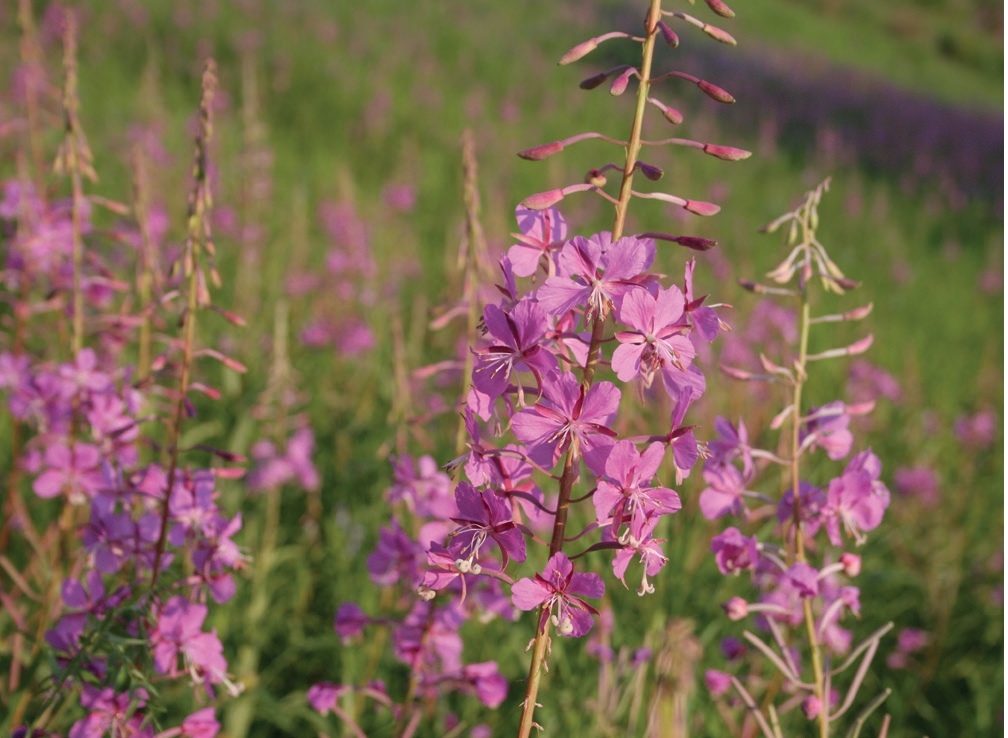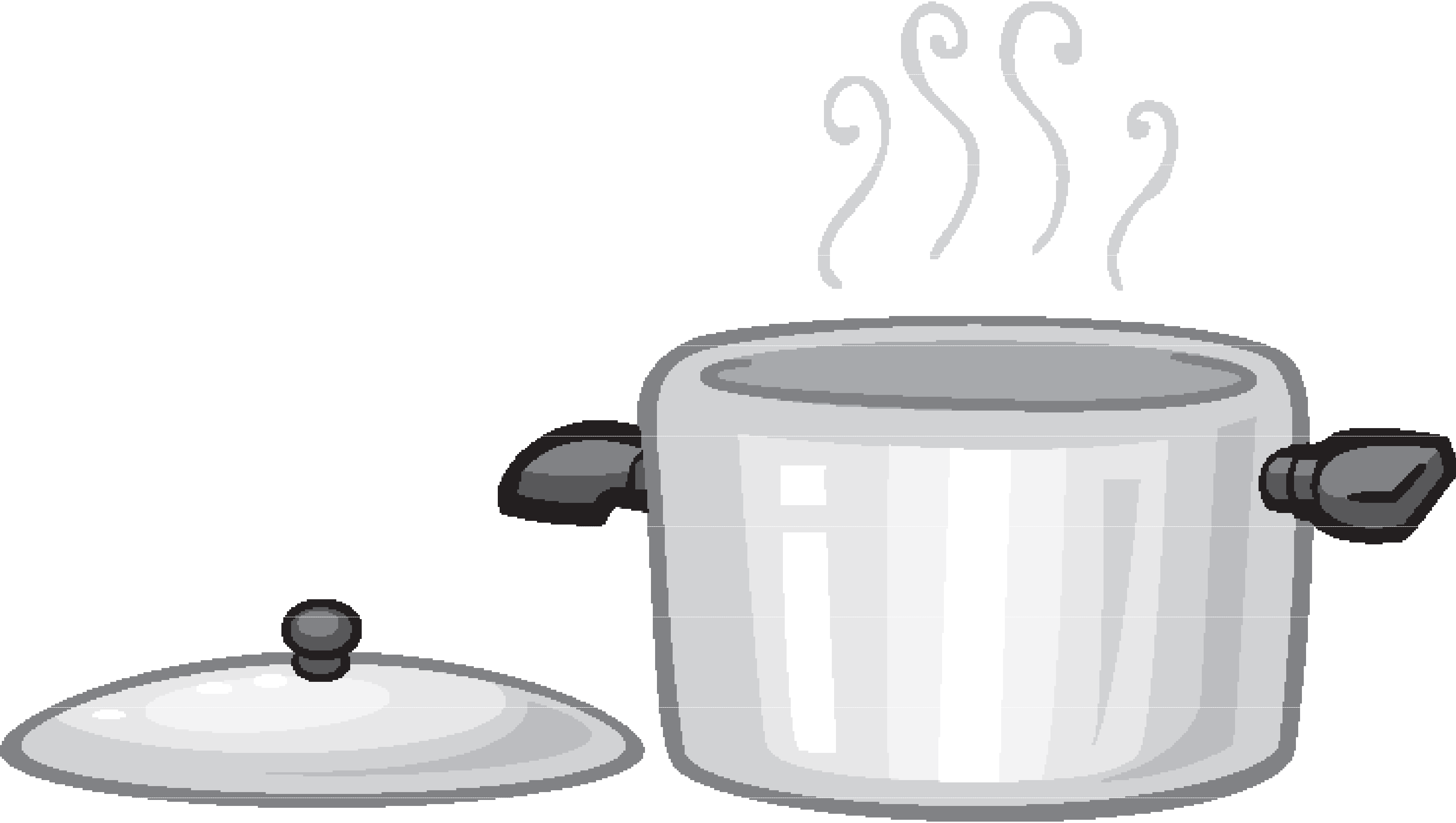Fireweed
FNH-00106 View this publication in PDF form to print or download.
Fireweed is a tall perennial herb with numerous dense, narrow lance-shaped leaves. Bright reddish-purple flowers grow in long terminal clusters and are very showy.
Fireweed is the common name for the perennial plant Epilobium angustifolium. You will find the plant growing in open meadows, in areas recently cleared of vegetation by wildfires and along riverbeds and roadsides.
Blooms begin at the base of the cluster and mature up the stem as the season progresses.
Alaskans say that summer has started when the blossoms lowest on the stem bloom and
that summer’s end is in sight when the blossoms reach the top of the stalk.
When first emerging from the ground, fireweed shoots can be harvested for food. They are a good source of vitamin C and vitamin A. The shoots and young leaves of the fireweed plant can be eaten raw, in salads, pickled, sautéed or steamed as you would asparagus.
Leaves and unopened buds also can be picked and used before the blossoms develop. The young, slender leaves and immature buds can be mixed with salad greens. As with many plants, the taste becomes stronger and the leaves become tougher later in the season, so harvest and eat leaves early in the spring.
After the fireweed begins to bloom, select young, undamaged blossoms for use in recipes. Older blossoms will be bitter. Fresh, bright pink blossoms can add color and mild flavor to a salad. Or the blossoms can be used in any of the recipes in this publication.
Storage and Preservation
How to clean and store
Wash leaves, stems, flowers and shoots with warm water in a colander to remove dust and bugs. Lay out on paper towels to air dry, or pat dry with towels. Fireweed should be stored in a covered container in the refrigerator as you would other salad greens.
How to dry
Spread the fireweed (blossoms or leaves) on paper towels in a single layer and allow to air dry approximately two days. Store in a sealed container in a cool, dry place.
How to extract juice
In a large saucepan bring 2½ cups water to a rapid boil. Pour boiling water over 2 cups hard-packed fireweed petals and buds (press fireweed down hard to measure 2 cups), let stand until cool. Refrigerate overnight to bring out the color. Strain through a jelly bag or several layers of cheesecloth.
Yield: 2½ cups
Hot pack for juice
Sterilize canning jars. Heat juice, stirring occasionally, until it begins to boil. Pour into hot jars, leaving ¼ inch headspace. Wipe jar rims. Adjust lids. Process in a boiling water canner.
- Pints or quarts: 5 minutes
Freezing juice
Pour into sterilized containers leaving ½ inch headspace. Seal, label with date, and freeze.
- To sterilize canning jars, boil in water for 5 minutes.
- To prepare two-piece lids (rings and tops), wash, rinse set aside until ready to use. Follow manufacturer’s directions for use.
- If less sugar is desired in recipes calling for pectin, be sure to use no-sugar-needed pectin and follow the instructions on the box.
- See later instructions on this page for how to use a boiling water canner.
Recipes
Fireweed Vinegar
- 2 cups fireweed blossoms and buds
- 1 cup rice or white wine vinegar
Rinse blossoms in a colander and let dry. Place blossoms in a sterilized jar and pour vinegar over the top. Place mixture in a dark place and allow it to steep for 3 to 4 weeks. Strain vinegar through a strainer or a paper coffee filter. Store in the refrigerator. For longer storage, process in a boiling water bath for 5 minutes.
Fireweed Scones
- 2 cups flour
- ¼ cup sugar
- 2 teaspoons baking powder
- ½ teaspoon baking soda
- ½ teaspoon salt
- 5 tablespoons butter
- 1 cup sour cream
- 1 egg yolk
- ½ cup fireweed blossoms
Mix dry ingredients together. Cut the butter into five pieces and cut it or mix with fingers into dry ingredients until crumbly. Mix sour cream and egg yolk together and mix with dry ingredients until all ingredients are combined. Dough will be sticky. Turn out onto a floured surface and sprinkle blossoms on top. Knead lightly (only about 10 times) to mix flowers in. Pat out into a square about ¾ inch thick. Cut into four squares and cut each square diagonally to make eight scones. Bake at 400°F for 12 to 15 minutes.
Fireweed Jelly
- 2½ cups fireweed juice
- 3 cups sugar
- 1 teaspoon lemon juice
- ½ teaspoon butter, margarine or oil
- 3 tablespoons powdered pectin
Sterilize canning jars and prepare lids. Combine fireweed juice, lemon juice, pectin and butter, margarine or oil in a large saucepan. Bring to a full rolling boil and boil hard for 1 minute, stirring constantly. Add sugar and boil hard for 1 minute, stirring constantly.
To test, drop ½ teaspoon of jelly on a cold saucer and put it in the freezer for 5 minutes. If the mixture does not set to your satisfaction, add ½ cup sugar to the jelly in the pot and boil hard for 1 minute. Retest. During the test, the rest of the jelly mixture should be removed from the heat.
When the test mixture gels to your satisfaction, ladle jelly into hot jars, add two-piece lids and process in a boiling water canner for 5 minutes.
Yield: 3 cups
Fireweed Tea
Gather leaves for tea before the plants flower, while leaves are young and tender. Place a generous handful of leaves in a warmed teapot and pour boiling water over them, filling the teapot. Steep for 5 to 10 minutes. The resulting tea is a light green color with a sweet taste. Fireweed tea does not require sugar or milk to improve its flavor. Fireweed tea blends well with other wild teas. Caution: fireweed tea can be mildly laxative; drink in moderation.
Fireweed & Clover Honey
- 6 cups sugar
- 3 cups boiling water
- 30 white clover blossoms
- 18 red clover blossoms
- 18 fireweed blossoms
Sterilize canning jars and prepare lids. Boil together sugar and water for 10 minutes; maintain steady boil on low heat without stirring. Remove from heat. Add blossoms and let steep for 15 minutes. Strain mixture through cheesecloth and immediately pour into hot canning jars, leaving ¼ inch headspace. Wipe jar rims and add prepared two-piece lids. Process 5 minutes in a boiling water canner.
Note: Sugar syrup can be tricky. If it crystallizes before canning, return it to the pan, add 2 tablespoons water per cup of honey and heat until crystals dissolve. Then process as above.
Fireweed Shoot Refrigerator Pickles
Corinne Conlon
- 2 quarts of fireweed shoots
- 2 cups water
- 2 cups apple cider vinegar
- 2 tablespoons kosher salt
- 1 tablespoon to 2/3 cup sugar (to taste)
- 6 one-pint jars
Spice mix ideas:
- 1 teaspoon mustard seeds, 1½ teaspoon dill seeds or fresh dill, one sliced small onion, 1¼ teaspoon chili flakes.
- 1 teaspoon coriander seeds, 1 teaspoon fennel seeds, 1 teaspoon black peppercorns
- juice of ½ lemon
- 2 spruce tips per jar.
Clean and rinse fireweed shoots. Combine water, vinegar, salt and sugar in a medium pan. Bring to a boil and stir to dissolve sugar and salt. Remove from heat and cool to room temperature. Place fireweed shoots in jars, leafy end up. Pour brine in each jar to cover the fireweed shoots. Seal with an airtight lid and store in the refrigerator for at least one week for flavors to develop. Makes approximately 6 pint jars.
Note: This recipe has not been safety tested for canning; store pickles in refrigerator. For best quality, eat within a few months.
- Fill the canner halfway with water. Preheat water to a low boil. Place filled jars, fitted with lids, into the canner on the rack. Add more boiling water, if needed, so the water level is at least 1 inch above jar tops. Turn heat to its highest position until water boils vigorously. When the water boils, set a timer for the recommended processing time indicated in the recipe. Cover with the canner lid and lower heat setting to maintain a gentle boil throughout the processing time. Add more boiling water, if needed, to keep the water level above the jars.
- When the jars have been boiled for the recommended time, turn off the heat and remove the canner lid. Using a jar lifter, remove the jars and place them on a towel, leaving at least 1 inch of space between the jars during cooling.
- After cooling jars for 12 to 24 hours, remove the screw bands and test seals. Press the middle of the lid with a finger. If the lid springs up when finger is released, the lid is unsealed. If a lid fails to seal on a jar, remove the lid and check the jar-sealing surface for tiny nicks. If necessary, change the jar, add a new, properly prepared lid and reprocess within 24 hours using the same processing time. Alternately, adjust headspace to 1½ inches and freeze or store in the refrigerator and use within three days.
- If lids are tightly sealed on cooled jars, remove screw bands, wash the lid and jar
to remove food residue, then rinse and dry jars. Label and date the jars. Store
in a clean, cool, dark, dry place.

UAF Cooperative Extension Service Resources
Jams and Jellies – FNH-00730
Canning Overview – FHN-00707
Using Alaska’s Wild Berries and Other Wild Edibles ($15), FNH-00120
Canning Basics, FNH-01280 - YouTube
Jams and Jellies, FNH-01290 - YouTube
Sarah R-P. Lewis, Extension Faculty, Health, Home and Family Development. Originally prepared by Roxie Rodgers Dinstel and Leslie Shallcross, Extension Faculty, Health, Home and Family Development.
Revised October 2023
